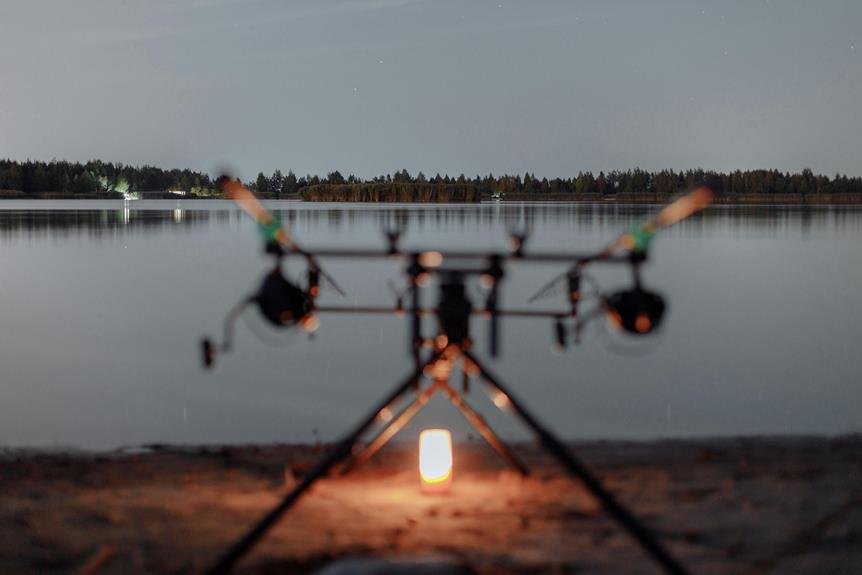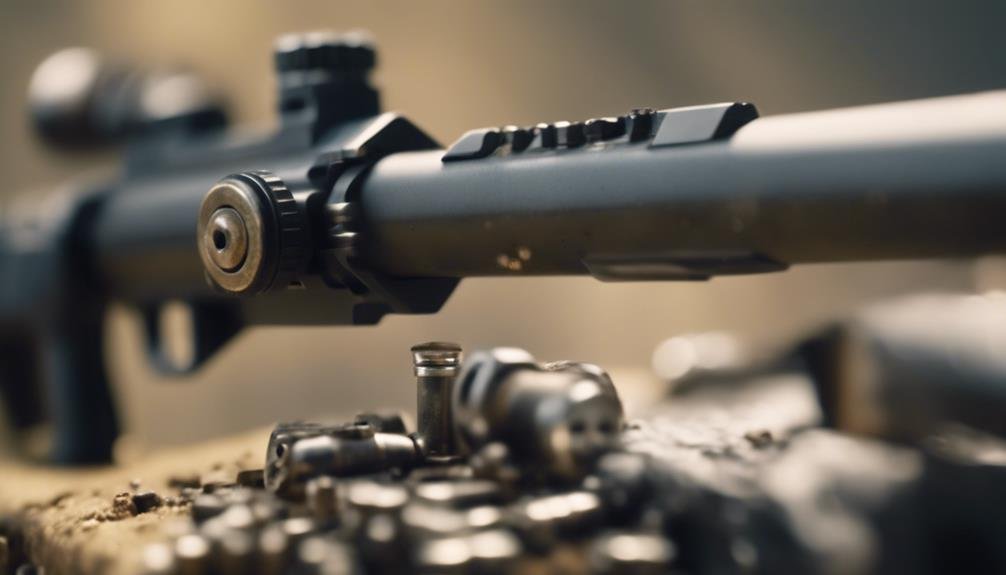Mastering fly fishing knots is essential for a secure connection between the fly line, leader, and fly. Five essential knots – the Nail Knot, Double Surgeons Knot, Double Turle Knot, Needle Knot, and Tube/Nail Needle Knot – form the foundation of a reliable fly fishing setup. Weak knots can lead to lost fish and gear, highlighting the importance of choosing the right knot. By understanding the unique applications of each knot, anglers can optimize their fishing techniques and minimize lost catches. As you explore the world of fly fishing knots, you'll discover the intricacies of each knot and how to tie them with confidence and precision.
Key Takeaways
- Mastering five essential fly fishing knots, including the Nail Knot and Double Surgeons Knot, is crucial for a secure connection.
- Practicing and perfecting knots is critical to ensuring a reliable connection and increasing chances of landing a trophy catch.
- Understanding the unique uses of each knot, such as the Nail Knot for backing to fly line, optimizes fishing techniques and minimizes lost catches.
- Tying the perfect knot requires a clean slate, proper tension, and double-checking work to ensure a snug and secure connection.
- Mastering fly fishing knots is just the beginning of understanding the fundamental principles and techniques of fly fishing.
Essential Fly Fishing Knots
The Nail Knot, Double Surgeons Knot, Double Turle Knot, Needle Knot, and Tube/Nail Needle Knot are the essential fly fishing knots that every angler should master to guarantee a secure connection between the fly line, leader, and fly. These knots are fundamental for maintaining a strong connection, as a weak knot can lead to lost fish and gear. The Knot Strength Debate highlights the importance of choosing the right knot for the job, as some knots are stronger than others. Proper Fishing Gear Maintenance is also essential, as a well-maintained setup can help prevent knot failure. By mastering these essential knots and prioritizing gear maintenance, anglers can confirm a reliable connection and increase their chances of landing that trophy catch.
Mastering Fly Fishing Knots
Five essential knots form the foundation of a reliable fly fishing setup, and mastering them is critical to ensuring a secure connection between the fly line, leader, and fly. To take your fly fishing skills to the next level, it's essential to practice and perfect these knots. Here are three key tips to help you master fly fishing knots:
- Invest in quality knot tying tools, such as a knot tying board or a pair of forceps, to help you tie knots more efficiently and accurately.
- Join online fly fishing communities to connect with other anglers, share tips, and learn from their experiences.
- Practice regularly, starting with simple knots and gradually moving on to more complex ones, to build muscle memory and confidence.
Common Fly Fishing Applications
One of the most critical aspects of fly fishing is understanding the common applications of various knots in different fishing scenarios. This knowledge enables anglers to select the most suitable knot for a specific fishing technique, ensuring a secure connection and minimizing the risk of lost fish.
| Knot | Application | Fishing Technique |
|---|---|---|
| Nail Knot | Backing to fly line | Dry fly fishing |
| Double Surgeons Knot | Leader to fly line | Nymphing |
| Needle Knot | Monofilament leader to fly line | Streamer fishing |
Tying the Perfect Knot
With a few simple twists and wraps, mastering the perfect knot can make all the difference in a successful day on the water. As anglers, we've all experienced Knot Anxiety, that nagging feeling of uncertainty when our knots don't hold. To overcome this, focus must be placed on Tension Control, ensuring a snug and secure connection. Here are three key takeaways to help you tie the perfect knot:
- Start with a clean slate: Make sure your line and leader are free of tangles and twists before attempting to tie a knot.
- Use the right amount of tension: Avoid over-tightening, which can cause damage to your line or leader.
- Double-check your work: Verify that your knot is secure by gently tugging on the line and leader.
Fly Fishing Knot Uses
In fly fishing, the right knot can make all the difference between landing a prized catch and watching it slip away, which is why understanding the various uses of each knot is essential. Different knots serve specific purposes in various fishing techniques, and mastering their applications is vital for effective line management. The Nail Knot, for instance, is ideal for connecting the backing to the fly line or the fly line to the leader. The Double Surgeons Knot, on the other hand, is perfect for joining monofilament lines of similar or dissimilar sizes. By understanding the unique uses of each knot, anglers can optimize their fishing techniques and minimize the risk of lost catches. With the right knot in the right situation, fishermen can secure a reliable connection and focus on reeling in the big one.
Learning Fly Fishing Essentials
Mastering the various fly fishing knots is just the beginning, as understanding the fundamental principles and techniques of fly fishing is equally important for a well-rounded angler. To build a strong foundation in fly fishing, you must grasp the basics. Here are three key aspects to focus on:
- Fly Fishing Basics: Understanding the concept of fly fishing, including the types of casts, presentations, and reading water.
- Fishing Gear Essentials: Familiarizing yourself with the necessary gear, such as rods, reels, lines, and leaders, and how to choose the right equipment for your fishing style.
- Practicing Techniques: Developing muscle memory through regular practice, including casting, knot tying, and fly presentation.
Knot Tying Techniques
Five essential knots form the foundation of fly fishing, and understanding their specific applications is crucial for a successful angling experience. To master these knots, developing a consistent tying technique is imperative. This requires patience, practice, and a deep understanding of the knot's mechanics. Knot Mastery is not just about tying the knot correctly, but also about understanding the Fishing Psychology behind it. A well-tied knot can boost confidence and reduce anxiety, allowing anglers to focus on the fishing experience. By mastering the techniques of knot tying, anglers can develop muscle memory, enabling them to tie knots quickly and efficiently, even in high-pressure situations. With consistent practice, anglers can refine their knot-tying skills, leading to a more enjoyable and successful fly fishing experience.
Additional Fishing Resources
Anglers seeking to further enhance their fly fishing experience can leverage a range of additional resources, from interactive maps and fish identification tools to newsletters and educational programs. These resources can help anglers refine their skills, explore new fishing spots, and stay up-to-date on the latest fishing trends.
Some notable resources include:
- Interactive Maps: Explore fishing hotspots and plan your next adventure with interactive maps that provide detailed information on fishing locations and conditions.
- Fish Identification Tools: Identify your catch with ease using online tools that provide detailed descriptions and images of various fish species.
- Fishing Communities and Online Forums: Connect with fellow anglers, share tips, and learn from others in online forums and fishing communities dedicated to fly fishing.
Frequently Asked Questions
Can I Use the Same Knot for Both Fresh and Saltwater Fishing?
When considering knot choice, vital knot versatility is required, making a single knot inadequate for both fresh and saltwater fishing conditions, which differ profoundly, as saltwater's corrosive nature demands added durability.
How Often Should I Replace My Fly Fishing Knots?
Just as a master craftsman regularly inspects and maintains their tools, a seasoned angler must regularly inspect and maintain their knots, replacing them every 6-12 months or sooner if signs of wear appear, to guarantee a secure catch.
Are Fly Fishing Knots Stronger When Wet or Dry?
When evaluating knot strength, consider knot porosity, as moisture can affect performance. Wet testing reveals that some knots, like the Nail Knot, can be stronger when wet, while others may weaken, emphasizing the importance of understanding specific knot properties.
Can I Use a Nail Knot for Connecting Two Lines of Different Materials?
Like a master weaver combining disparate threads, connecting two lines of different materials requires careful consideration. The Nail Knot's strength relies on material compatibility, so guarantee the lines' properties harmonize, lest the union unravels under stress.
Do I Need to Use a Specific Type of Line for Each Fly Fishing Knot?
When selecting lines for fly fishing knots, consider the material, diameter, and strength to achieve maximum knot strength; matching line type and size to the specific knot's requirements is vital for reliable connections and successful fishing excursions.
Conclusion
In the intricate dance of fly fishing, knots serve as the unsung heroes, weaving together the threads of success and disappointment. Mastering these essential knots is akin to deciphering the secrets of the water, where a single misstep can spell disaster. By grasping the nuances of these critical connections, anglers can cast aside doubt and reel in confidence, their lines strengthened by the unyielding bonds of skill and precision.









